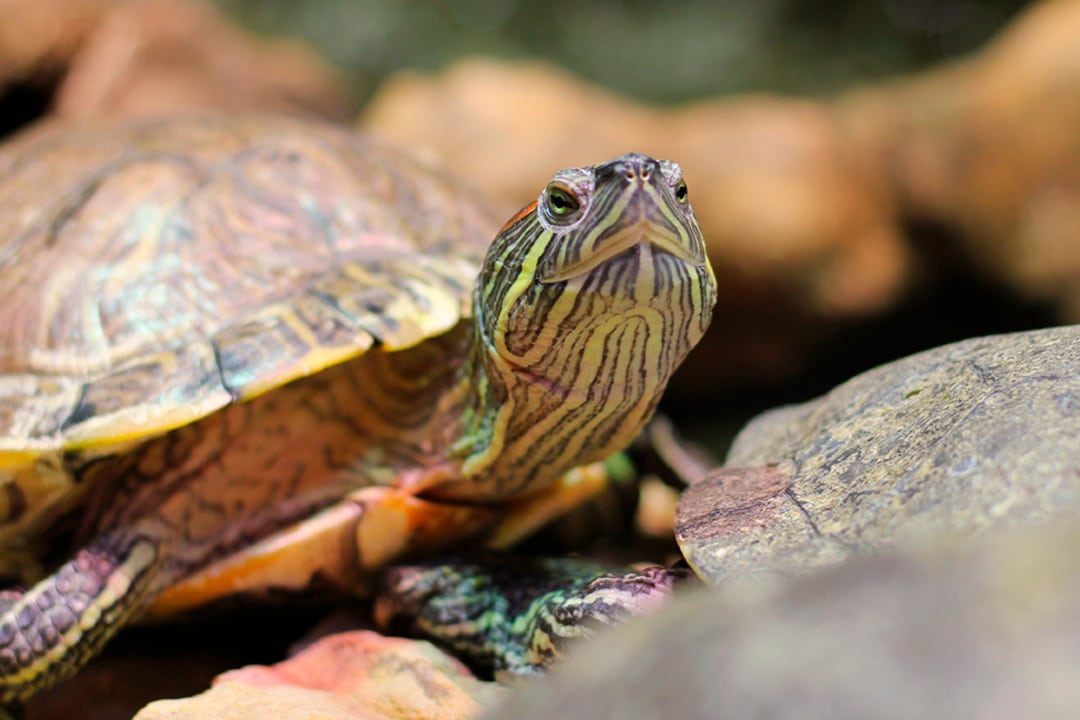“Do the right thing for your animal and your earth. Research, prepare and practice responsible stewardship by keeping captive-bred turtles.”
Aquatic turtles are unique pets with distinct personalities that many pet owners fall in love with. However, with their uniqueness comes a specific set of care requirements. We talked to Mazuri Regional Manager, former professional animal keeper and 40-year hobbyist Scott Davis to learn more about how pet owners should prepare to responsibly bring a turtle into their home. Whether you are new to the world of turtles or looking to brush up on your turtle care knowledge, here are a few things Scott advises keeping in your toolkit.
Finding Your Turtle
To be a responsible turtle caretaker, Scott stresses the importance of acquiring only captive-bred turtles. If you find a turtle crossing the roadway, for example, it’s not advisable to bring the animal home. While the turtle is likely to appreciate your careful assistance in safely arriving on the other side of the road, it’s best to assume it has an established life in this environment. Similarly, it is not recommended to release captive-bred turtles in the wild, as this can cause irreparable damage to native ecosystems as well as your pet. Sufficient preparation and an in-depth understanding of your turtle species is key to honoring your commitment as a pet owner.
Before you bring a turtle home, do your research to make sure you have a good understanding of its unique needs, lifespan and the commitment you’re signing up for. Some aquatic turtles can live up to 40 years in captivity and should not be an impulse buy, Scott advises.
“Do the right thing for your animal and your earth. Research, prepare and practice responsible stewardship by keeping captive-bred turtles.”
Creating Your Turtle’s Dream Home
There are several key considerations to keep in mind as you prepare to introduce an aquatic turtle to a new environment. Being cold-blooded reptiles, turtles are ectotherms, which means they require constant temperature regulation. To allow a turtle to thermoregulate in their tank, a warm side should be augmented by a heat lamp over a dry spot for basking, while a cooler side of the tank should have a dry area available and accessible for your pet to fully haul out and dry off as needed. Scott also recommends an aquarium large enough for your pet to heat up, cool down and adjust their body temperature as needed. A submersible, protected heater is recommended to safely heat an aquatic environment to a constant, ideal temperature of 78 degrees Fahrenheit.
The size of the tank is dependent on the species of turtle, but many aquatic turtles can become very large and have a long lifespan, so bigger is generally better. Be sure to research the full adult size of your turtle to ensure its habitat is appropriately sized to allow for both exploration and growth.
In addition to plenty of space, turtles require a few accessories and regular maintenance to keep them happy and healthy. A reliable source of UV light is essential for bone and shell development.
“Adequate UV light is best accomplished by installing specialized UV fluorescent bulbs spanning the length of your turtle’s environment so they can be consistently exposed to light,” advised Scott. “A common misconception is that placement of a tank near a window will suffice to provide a turtle with necessary UV light. Unfortunately, glass is UV retardant, and keeping an environment near a window makes your turtle’s habitat more susceptible to inconsistencies in temperature that could be detrimental to its health.”

The size of the tank is dependent on the species of turtle, but many aquatic turtles can become very large and have a long lifespan, so bigger is generally better. Photo by Shutterstock
As aquatic creatures, turtles spend a fair amount of time in water. In fact, they have the impressive ability to use their cloaca, an opening underneath a turtle’s tail used for excretion, defacation and reproduction, for respiration and gas exchange. As Scott puts it, this means your pet can breathe with its butt!
When it comes to your turtle’s swimming area, clean water is a must. To maintain ideal conditions for your aquatic turtle, make sure there is good water filtration, remove any physical debris and, if you do not have consistent filtration, change the water at least once per week along with thorough hand washes immediately after handling your pet. In addition, Scott advises caretakers to make sure the water is not too deep to ensure your turtle does not drown.
Providing Complete Pet Nutrition
Along with a suitable environment, nutrition plays a critical role in the health and happiness of your turtle.
Mazuri® Aquatic Turtle Diet is a nutritionally complete turtle food for all freshwater species and stages of life. Since it’s a complete diet, all necessary components of your pet’s nutritional needs are accounted for in its formulation. In fact, all Mazuri diets are formulated by in house Ph.D Exotic Animal Nutritionists and manufactured to exacting standards to ensure the best quality and complete, constant nutrition for your pet. Additionally, common ailments experienced by freshwater turtles can be prevented and treated by feeding this complete diet.
“Metabolic bone disease and vitamin A deficiency can be mitigated by the right nutrition coupled with provision of UV lighting, aiding your pet’s bone deposition, growth rate and avoidance of skeletal and bone deformities. A complete diet consists of everything a turtle needs,” shared Scott.
The only necessary supplementation to a complete turtle diet is for the benthic species, the aquatic turtles that dwell well below the water’s surface. Snapping turtles, mud turtles and musk turtles tend to require more protein, since they are accustomed to feeding on decaying animal material found on the bottom of a natural aquatic environment. Benthic dietary needs can be managed with Mazuri® Aquatic Turtle Gel.
Enrichment snacks, like earthworms, crickets and other insects, are not nutritionally necessary if you’re feeding a complete turtle diet, but can be a valuable supplement to encourage natural behaviors and stimulation. If you’re interested in feeding these critters, be sure to purchase them from a local pet retailer rather than collecting from the wild. Otherwise, unknown contaminants could be introduced to your turtle’s environment and potentially have detrimental effects on the health of your pet.
An aquatic turtle that is properly cared for can make an amazing companion. With careful preparation, diligent research and a toolkit full of Scott Davis’ expert advice, you can take pleasure in knowing you are providing your turtle friend with a high-quality life and rewarding lifelong relationship.
For more reptile care and nutrition tips, find Mazuri on Facebook and Instagram.



